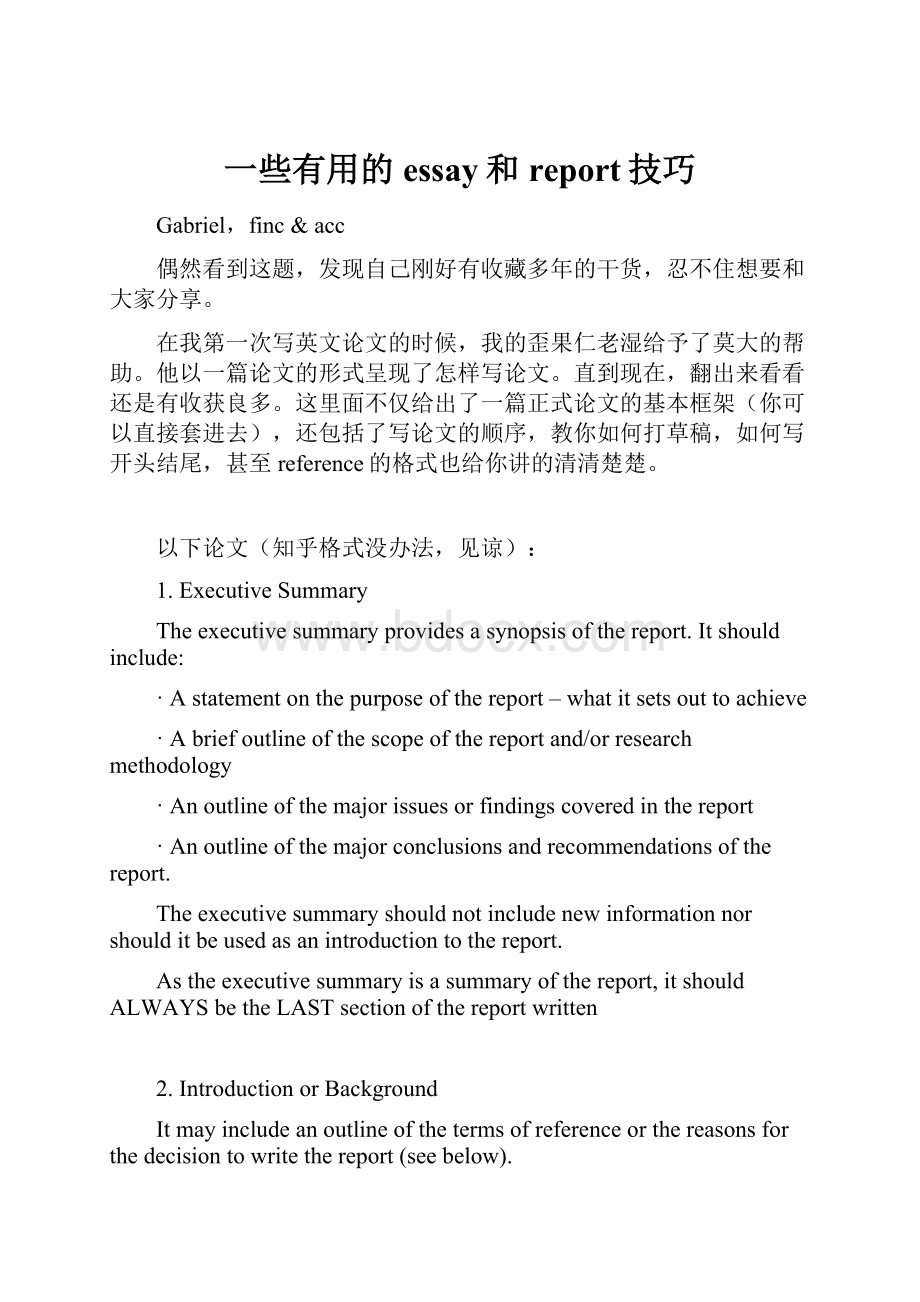一些有用的essay和report技巧.docx
《一些有用的essay和report技巧.docx》由会员分享,可在线阅读,更多相关《一些有用的essay和report技巧.docx(13页珍藏版)》请在冰豆网上搜索。

一些有用的essay和report技巧
Gabriel,finc&acc
偶然看到这题,发现自己刚好有收藏多年的干货,忍不住想要和大家分享。
在我第一次写英文论文的时候,我的歪果仁老湿给予了莫大的帮助。
他以一篇论文的形式呈现了怎样写论文。
直到现在,翻出来看看还是有收获良多。
这里面不仅给出了一篇正式论文的基本框架(你可以直接套进去),还包括了写论文的顺序,教你如何打草稿,如何写开头结尾,甚至reference的格式也给你讲的清清楚楚。
以下论文(知乎格式没办法,见谅):
1.ExecutiveSummary
Theexecutivesummaryprovidesasynopsisofthereport.Itshouldinclude:
·Astatementonthepurposeofthereport–whatitsetsouttoachieve
·Abriefoutlineofthescopeofthereportand/orresearchmethodology
·Anoutlineofthemajorissuesorfindingscoveredinthereport
·Anoutlineofthemajorconclusionsandrecommendationsofthereport.
Theexecutivesummaryshouldnotincludenewinformationnorshoulditbeusedasanintroductiontothereport.
Astheexecutivesummaryisasummaryofthereport,itshouldALWAYSbetheLASTsectionofthereportwritten
2.IntroductionorBackground
Itmayincludeanoutlineofthetermsofreferenceorthereasonsforthedecisiontowritethereport(seebelow).
Explainthebackgroundtotheissue/problem/topic(thiscouldbethehistory,etc.thathelpsusunderstandtheissue/problem/topic.
Whatarethedifferentpointsofview/opinionsabouttheissue/problem/topic?
Whatislikelytohappeninthefuture?
Thisreportwasrequestedbyanumberofstudentshavingdifficultyunderstandinghowtowriteareport.
Thisreportaimstogivestudentsaplantofollowwhenpreparingtheirmaterialandanexampleofthelayoutofareport.
Thematerialforthisreportwasgatheredfromvariousbooksandwebsiteswhichwillbereferredtolater.Thisformatisnottheonlywaytowriteareport.
ItiswrittenespeciallyforstudentsundertakingAcademicEnglish.However,itcanbeausefulguidetoanystudentinanysubject.
3.ScopeofReportorResearchObjectives
Outlinethepurposeofyourreport.
Thescopeofthereportshoulddefinemajorissuesorresearchobjectivestobeaddressedbythereport.
Ifindoubt,askyouteacher.Theymaybeabletohelpyoufindtherightplacetolookforinformation.
4.ResearchMethodology
Mostreportswillinclude:
·4.1primarysourcesofinformation–surveys,questionnaires
·4.2secondarysourcesofinformation–books,internet
Thissectionneedstodetailhowtheinformationforthereportwasobtainedandanylimitations.Theplacetostartisinyourownhead.Howmuchdoyoualreadyknowaboutthetopic?
Writeeverythingdown.
Usethelibrary.Notjusttheinternet.Therearebooks,magazines,newspapers,andstafftohelpyou.Takenotesandorganisetheinformationinafolder.
Remembertowritedownalltheinformationaboutanybookorwebsite,etc.forthebibliography:
author,title,datepublished,publisherandplacepublished(seeAppendixBofthisreport).
Notetakingskillsarenecessarywhenreadinginformationandyoumustsummarisemuchofthatinformation.
5.DetailedFindings
Thelargestsectionofthereport–itwillcontainalltheinformationandanalysis,includingtables,chartsanddiagrams.
ThebodymustbedividedintologicalsectionsandsubsectionswithheadingsidenticaltothoseintheTableofContents.
Itwillincludeheadingsandsub-headingswhichreflectthecontentsofeachsection.
AlthoughareportstartswithasynopsisdonotstartwritingituntilAFTERyoufinishtheintroduction,bodyandconclusioninthatorder.
5.1FIRSTDRAFT
Dividethebodyofthereportintoheadingsandsubheadings,soeachsectioncanbewrittenonitsown.Thismakesthetaskseemeasier.
Usethepassivevoice(revisethissectionofEnglishonCue,Module5).Useshortsentencesandsimple,formallanguage.Includepicturesifyouwanttomakeitmoreinterestinge.g.”Diagram2showsthat……”
Useyourcomputer’sspellcheckandprintpreviewwherepossible.Planthepagescarefully.Carelesslayoutwilllosemarks.Checkgrammarandpunctuation.
Whenreferencingabook,etc.inyourwritingrememberquotingdirectlymustusequotationmarkse.g.“TherearemanyreasonswhypeoplevisitAustralia…..”(Smith2012).
Indirectquotes(paraphrasing):
Smith(2012)saystherearemanydifferentreasonspeoplewanttovisitAustralia.
Savetwocopies:
oneonyourcomputerandoneonaUSB.Lostworkmeansstartingagain.
5.2SECONDDRAFT
Producingtheseconddraftisnothardonceyourfirstdraftofthereportisedited,typedandsaved.
6.ConclusionandRecommendations
Thisisasummaryofthemainfindingsofthereport,especiallythosethatareforthereader/client.
Conclusionshouldtellwhatthedetailedfindingsmeanforthereader/clientinrelationtothescopeofthereportorresearchobjectives.
Therecommendationsshouldlisttheactionthatyourecommendshouldbetakenbasedontheseconclusions.
6.1CONCLUSION
Itishopedthisguidewillbenefitstudentsinatleasttwoways.Firstly,togiveastepbystepmethodtoreportwriting.Secondly,itistobeusedasanexampleofreportwriting.
Theprocessofreportwritingisobviouslyalongandcomplexone.Eachstepshouldbecompletedbeforemovingontothenextone.DoNOTputoffstartingtoresearchandwritejustbecauseitisdifficult.
Makesuretheinformationinthereportisrelevanttothetopicanddiscussestheissuesmentionedintheintroduction.
6.2RECOMMENDATIONS
+Takeonestepatatime
+Donotwastetime
+Usealltheresourcesavailable
+Talktoyourteacherifindoubt
+Startnow
7BIBLIOGRAPHY
Thebibliographyisanalphabeticallistofreferencesusedinpreparationofthereport
Studentsshouldrefertotheirtextbookforguidelinesonhowtocorrectlyreferenceinformationsources.
Jordan,R.R(1990)AcademicWritingCourse,CollinsELT,London.
Mangubhai,FrancisandPritchard,R(1996)EnglishonCue,USQ,Toowoomba.
http:
//www.epa.vic.gov.au/ecologicalfootprint/globalfootprint/index.asp
APPENDIX
Theappendicessectionisformaterialthatisrelevantandisreferredtointhereport,butistoolongorisnotnecessarytobeincludedinthebodyofthereport.
Examples:
Questionnaire
Appendicestobelabelled:
AppendixA,AppendixBetc.
WRITINGABIBLIOGRAPHY
Takecarefulnoteoftheorderinwhichtheinformationappearsbelow–alphabetically!
Theformatisdifferentforbooks,magazinesandinternet.Mostentriesbeginwithanauthorbutifnotthenthetitle,etc.isshown.
1.0BOOKS
Author’sfamilyname,initialorfirstname,(dateofpublication),titleinitalics,nameofpublisher,placewherepublished.
Barron,ML(2010)BusinessFinance,McGraw-Hill,Sydney.
Kitchen,PD(Ed.)(1997)BusinessLaw:
Fundamentals,Thompson,London.
Brown,MandWhite,P(2000)WritingAssignments,ThomasNelson,Melbourne.
2.0JOURNALS/MAGAZINES/NEWSPAPERS
Author’sfamilyname,initialorfirstname,(dateofpublication),“titleofarticle”,nameofjournalinitalics,volumenumber,(issuenumber),pp.numbers.
Smith,B(2002)“Canyouwriteanessay?
”,EducationTimes,64,(10),pp.24-28.
Mitchell,Ben(2000)“StudentsfailEnglishtest”,XinHua,13September,p.5.
3.0WebSites
Author’sfamilyname,firstname/initial,(dateofpublication),titleofpageinitalics,URL,dateaccessed.Or
Titleofpage,URL,dateaccessed.
Quinion,M,(1996)Citingonlinesources.AdviceononlinecitationsformatsWorldWideWords:
CitingOnlineSources(Accessed7.9.2013)
Informationresource,www.immi.gov.au/visas(Accessed20/10/2012)
Thepaperthatyouarerequestedtowriteshouldbearesearchpaper,meaningthatitsgoalistopresentthereaderwithasomewhatnew,originalwayoflookingataconceptoridea.Inadditiontoanalyzingprimarysources–thenovel(s),play(s),poem(s),oressay(s)thatyouchoseasyourfocus–aresearchpaperprovidesacontextforitsargumentbysummarizingandcommentingonsecondarysources,whichareotherpeople’sanalysesofprimarysources.Hencearesearchpaperisnotjustasummaryofotherpeople’sideas.Instead,aresearchpapershouldevaluatethoseideasandeitherproposeanewargumentordevelopanexistingone.Thefollowingstepsshouldhelpyouplanandthenwriteyourpaper.
1.STRUCTURINGYOURARGUMENT
a)Revisityourpaperproposalandthinkaboutthequestionsandtheargumentthatcompriseyourthesis(youmightneedtorefine,reformulateorexpandthemslightlyatthisstage).
b)Revisityourprimarysources.Lookforpatternsinyourobservationsaboutatextoreventandtakenotes.Asyoureadthroughyourlistofevidence,lookforideasthatcontradicteachother,change,orarenotfullyexplained.Whenwritingaboutliterature,asymbol’smeaningmightchangeorcontradictitselfinapoem,oracharactermightchangehisorherattitudetowardanidea.
c)Skimthroughthetext(s)againtofindspecificquotationsandanyotherexamplesyoumayhavemissed.Consultthesecondarysourcesthatyouhavegathered.Focusonevidencethatrelatestoyourtopicandstrikesyouasparticularlyinteresting,confusing,orastute.Thinkabouthoweachpieceofevidencesupportsorcontradictsyourtopic.
d)Takenotes.Itisagoodideatonoteeachpieceofevidencethatmayberelevanttoyouressay.Listthesourceandpagenumber,andmakesureitisclearwhethereachpieceofevidenceisadirectcitation),acloseparaphrase,oryourownanalysisorinterpretation.
e)DefineaMotiveorPurposeforWriting.Agoodpapershouldbeinterestingtoabroaderaudience.Whenyouexpressyourmotive,youindicatewhyyouarewritingyourpaper.Themotiveisnottheargumentitselfbutratherthereasonthatyourargumentshouldbeinterestingtoyourreader.Motivesmaytakeintoaccountwhatothercriticshavewritten,commonperceptionsofanevent,orhistoricalcontext.
Someexamplesofmotives:
--“ManycriticsseetherelationshipbetweenHuckandJimasfairandharmonio